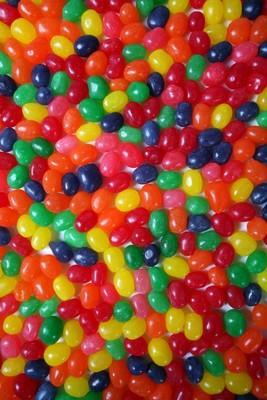Spilling the Beans

With chocolate Easter bunnies taking center stage today in all their solid or hollow goodness, it’s easy to forget what is probably the most ubiquitous and underappreciated of all Easter candies: the jelly bean.
This humble ball of gooey sugar in a crunchy shell manages to sit unnoticed in the bottom of Easter baskets everywhere, while flashier candies — think marshmallow animals and cream-filled eggs — shine in the holiday spotlight. They’re either loved or hated; there is no in between when it comes to jelly beans.
Still, more than 5 billion will be consumed this Easter, according to consumer statistics from Jelly Belly Candy Co., the leading jelly bean manufacturer.
Maybe you’ve wondered why jelly beans are synonymous with Easter. Or maybe you haven’t, you just take it for granted.
Even candy makers don’t know for certain how they became a traditional Easter candy. One guess is because jelly beans are shaped like eggs. Easter is about renewal, it’s a spring holiday and nothing says spring more than eggs. Or something like that.
“It’s hard to celebrate Easter without jelly beans,” says Susan Fussell, spokeswoman for the National Confectioners Association.
The connection developed in the 1930s when German immigrants introduced their holiday customs to the United States, she explains. The Germans believed that an Easter hare placed brightly colored eggs in the gardens of good boys and girls, Fussell says. That concept evolved into the American Easter bunny and the whole egg idea.
“In the U.S., the Easter bunny brought all kinds of eggs, even things that looked like eggs,” she says. “This included jelly beans. And their colors were very spring.”
The first jelly bean probably was invented in the mid-18th century, however. It’s likely they are a spinoff of Turkish delight, which has a similar consistency in the middle, Fussell says. Jelly beans feature a crunchy sugar shell, though. The cooking process, called panning, gives jelly beans their signature shape and sugar shell.
The history is murky because many candy makers were inventing candies at that time and they had no way to communicate with each other, she adds. Flavors were basic in the beginning. While some were molasses, peppermint and lemon, most were just sugar-flavored.
“It’s quite likely that the first jelly beans had no flavors,” Fussell says.
In the 1970s, the idea of the gourmet jelly bean was born. Jelly beans historically derived their flavor from the shell, Fussell says. In 1976, Jelly Belly came up with the idea of putting flavor in the center.
That, along with selling them as single flavors in addition to mixed bags, helped to popularize jelly beans year-round, notes Bill Kelley, a fourth-generation candy maker and vice-chairman of Jelly Belly.
In the 1980s, President Ronald Reagan’s penchant for the candies raised their profile even more. Jelly Belly created a blueberry flavor so that he could eat red, white and blue jelly beans in the White House.
Now, several companies produce gourmet jelly beans, including Russell Stover candies, Gimbal’s, Teenie Beanie and Smucker’s.
“In the last five or six years, we’ve seen more of those kinds of candies come onto the market,” Fussell says.
Starburst, Life Savers and Crayola make jelly beans now, which gives a whole new meaning to eating your crayons.
If you ask people their favorite flavor, they say red, Fussell says. They probably can’t tell whether the red is strawberry or cherry, but those are the traditional red flavors.
There are the savory beans, such as Just Baked Bean, and the not-so-savory: Dirt, booger, earwax, vomit and the other flavors of Bertie Bott’s Jelly Beans. The candies debuted in 2001 as a tie-in to the popular Harry Potter series. As the character’s preferred jelly beans, Bertie Bott’s appeals to kids with their strange flavors mixed in with traditionally flavored jelly beans, Fussell says.
THE PROCESSOn average, it takes a week to make a jelly bean, notes Susan Fussell, spokeswoman for the National Confectioners Association.
The candy begins as the tiny center made of sugar and corn syrup. It’s boiled and put into a starch mold. Once it’s cooled and set, the candy goes into a panner, which is usually a large copper rotating drum, Fussell says. As the candy rotates, the cook adds sugar, which builds up the outer shell of the jelly bean. Color and flavor are added and at the end, a confectioners’ glaze gives them the shiny, finished look.
Other candies prepared through panning included Boston baked beans, Lemonheads and Red Hots, Fussell says.


















